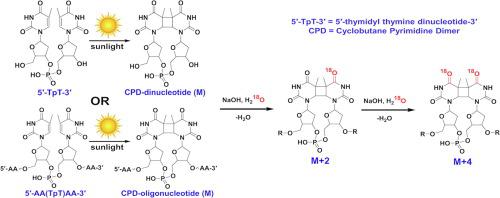Bioorganic & Medicinal Chemistry ( IF 3.3 ) Pub Date : 2021-11-10 , DOI: 10.1016/j.bmc.2021.116499 Ritu Chaturvedi 1 , Eric C Long 1

|
Cyclobutane pyrimidine dimers (CPDs) are the most abundant mutagenic DNA lesions formed in mammalian cells upon exposure to UV-B radiation (280–315 nm) in sunlight. These lesions are thought to be chemically stable and to withstand high concentrations of acids and bases.While earlier investigations of DNA lesions containing saturated pyrimidines have shown that the C4 carbonyl is a potential target of nucleophilic attack, similar reactions with thymine nucleobase model CPDs clearly showed that the cis-syn CPD (major isomer) is stable in the presence of a high concentration of alkali at room temperature. Here is described the alkaline reactivity of these lesions when contained within a dinucleotide CPD model system. Results using cis-syn CPD formed from dinucleotide 5′-TpT-3′ combined with [18O]-labelling indicated that CPD undergoes a water addition at the C4=O groups of these now saturated rings. The intermediate formed, however, completely reverts to the starting lesion. Along with confirming the target of water addition within CPD lesions, it was also determined that the two C4 carbonyls present on adjacent saturated pyrimidine rings of the photolesion undergo water exchange at different rates (3′ > 5′). Moreover, the difference in reactivity exhibited by these two positions is not limited to a dinucleotide and was observed also in oligonucleotides. Overall, a full understanding of the chemistry of CPD lesions is crucial to our knowledge of naturally-occuring DNA modifications and may lead to further insight into their detection, modification, and biochemical recognition & repair.
中文翻译:

碱性条件下二核苷酸和寡核苷酸模型环丁烷嘧啶二聚体 (CPD) DNA 损伤的机理研究
环丁烷嘧啶二聚体 (CPD) 是哺乳动物细胞在阳光下暴露于 UV-B 辐射 (280–315 nm) 后形成的最丰富的诱变 DNA 损伤。这些损伤被认为是化学稳定的,可以承受高浓度的酸和碱。虽然对含有饱和嘧啶的 DNA 损伤的早期研究表明,C4 羰基是亲核攻击的潜在目标,但与胸腺嘧啶核碱基模型 CPD 的类似反应清楚地表明cis-syn CPD(主要异构体)在室温下在高浓度碱存在下是稳定的。这里描述了当包含在二核苷酸 CPD 模型系统中时这些病变的碱性反应性。使用cis-syn 的结果由二核苷酸 5'-TpT-3' 结合 [ 18 O]-标记形成的 CPD 表明 CPD 在这些现已饱和的环的 C4=O 基团处经历了加水。然而,形成的中间体完全恢复到起始病变。除了确定 CPD 病变内加水的目标外,还确定了光病变相邻饱和嘧啶环上存在的两个 C4 羰基以不同的速率进行水交换 (3' >5')。此外,这两个位置表现出的反应性差异不限于二核苷酸,在寡核苷酸中也观察到。总体而言,全面了解 CPD 病变的化学性质对于我们了解自然发生的 DNA 修饰至关重要,并可能导致进一步了解其检测、修饰和生化识别和修复。




















































 京公网安备 11010802027423号
京公网安备 11010802027423号